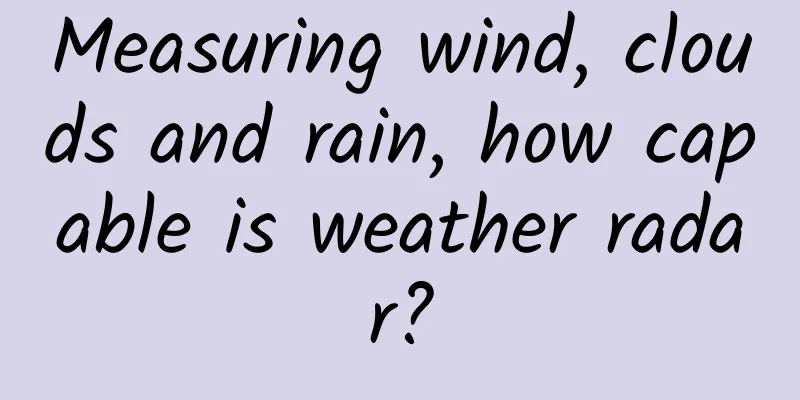Measuring wind, clouds and rain, how capable is weather radar?

|
Author: Haiyueming Studio Weather radar and weather satellites play an important role in weather observation and weather forecasting. They provide us with rich weather information and help us better understand and respond to weather changes. Today, let's focus on weather radar, a technological tool, and explore its wide application and far-reaching impact in our daily lives. Meteorological radar is a radar specially used for meteorological detection, which belongs to active microwave atmospheric remote sensing equipment. Meteorological radar is one of the main detection tools used for warning and forecasting small and medium-scale weather systems. It determines the location and characteristics of the target by the reflection of radar waves by the target. Conventional radar devices are generally composed of directional antennas, transmitters, receivers, antenna controllers, displays and cameras, as well as electronic computers and image transmission. Meteorological radar can monitor and warn of disastrous weather, and can judge whether it is stratus precipitation or cumulus precipitation based on the echo; it can identify whether hail or tornadoes are likely to occur; it can accurately analyze and identify specific structural distributions in some weather systems. In addition, there are quantitative estimates of large-scale precipitation and monitoring of real-time wind field information. Another point is that it can improve the initial value field of the high-resolution numerical weather forecast model. By communicating with the radar reflectivity factor and radial velocity data, the disposal field accuracy of the high-resolution numerical weather forecast model can be greatly improved, thereby improving the high-resolution numerical weather forecast. The main meteorological radars include: cloud measurement radar, rain measurement radar, wind measurement radar, and circular polarization radar. Cloud radar. It is a radar used to detect the height, thickness and physical characteristics of clouds before precipitation. Its commonly used wavelength is 1.25 cm or 0.86 cm. Its working principle is the same as that of rain radar, and it is mainly used to detect the height of cloud tops and cloud bottoms. If there are multiple layers of clouds in the sky, the height of each layer can also be measured. Since cloud particles are smaller than precipitation particles, the working wavelength of cloud radar is shorter. Cloud radar can only detect high-level clouds and middle-level clouds with relatively few clouds. For low-level clouds with a large water content, such as cumulonimbus clouds and hail, the beam of cloud radar is difficult to penetrate, so it can only be detected by rain radar. Rain radar. Also known as weather radar, it uses the scattering effect of electromagnetic waves by raindrops, cloud droplets, ice crystals, snowflakes, etc. to detect the concentration, distribution, movement and evolution of precipitation in the atmosphere or large droplets in the cloud, and understand the structure and characteristics of the weather system. Rain radar can detect typhoons, local strong storms, hail, heavy rain and strong convective clouds, etc., and can monitor weather changes. Wind radar. It is used to detect the horizontal wind direction, wind speed, and meteorological elements such as air pressure, temperature, and humidity in different atmospheric layers at high altitudes. The detection method of wind radar is generally to track the reflective target or transponder hung on the balloon to continuously locate the balloon. According to the displacement of the balloon per unit time, the horizontal wind direction and wind speed in different atmospheric layers can be determined. There is also a sounding instrument hung on the balloon to remotely measure the air pressure, temperature, and humidity at high altitudes. Circular polarization radar. General weather radars emit horizontally polarized waves or vertically polarized waves, while circular polarization radars emit circularly polarized waves. When the radar emits circularly polarized waves, the echo of spherical raindrops will be circularly polarized waves rotating in the opposite direction, and non-spherical large particles (such as hail) will cause depolarization of circularly polarized waves. By using the echo characteristics of the depolarization properties of non-spherical hail, circular polarization radar can be used to identify whether there is hail in the storm. How to understand weather radar images is a scientific and practical skill, which requires us to master certain basic knowledge and methods. Here are some guidelines on how to read radar images: There are red, yellow, blue and green blocks on the radar image, which are radar echoes. Cold colors - such as blue and green - indicate mild weather such as cloudy days or light rain, and the warmer the color - yellow, red, etc. - means the weather in that area is more intense. Blue: The area corresponding to the echo indicates that the local area is covered by precipitation clouds, but no rainfall has occurred yet; Green: The area covered by the echo represents the area being "immersed" in drizzle; Yellow to red: moderate to heavy rain is expected in the area covered by the echo. Generally, the yellow area corresponds to a rainfall intensity of about 10 mm per hour; the orange radar echo generally corresponds to a rainfall intensity of about 20 mm per hour, and there is a possibility of short-term thunderstorms, gale, hail and other severe convective weather. Vermilion - hourly rainfall intensity is 28 to 48 mm per hour, bright red - hourly rainfall intensity is 58 to 99 mm per hour, deep red - hourly rainfall intensity is 120 to 205 mm per hour. Purple - The area "covered with purple echoes" has the heaviest precipitation intensity. The area is "falling" into heavy rain or even torrential rain, and may be accompanied by severe weather such as thunderstorms, strong winds and even hail. Meteorological radar is mainly used to detect meteorological conditions and changing trends. It has been widely used in weather forecasts and professional meteorological services in the fields of agriculture, hydrology, forestry, transportation, energy, ocean, aviation, aerospace, national defense, construction, tourism, and medical care. It is an avionics product developed by people to prevent meteorological risks and ensure flight safety. It uses the principle that electromagnetic waves are reflected back after encountering obstacles after being radiated by antennas. The higher the conductivity of the target and the larger the reflecting surface, the stronger the echo. It can continuously provide pilots with meteorological conditions ahead of and on both sides of the route during flight. In addition, it also provides a map-type display of the surface features ahead of the aircraft, so that pilots can choose safe routes, avoid dangerous meteorological areas or other obstacles, identify landmarks, and determine the location of the aircraft. Weather radar and weather satellite each have their own unique characteristics and functions in weather observation and forecasting. Based on the above introduction, we have learned about weather radar, and now we will introduce the relevant content of weather satellite. Meteorological satellites are artificial satellites that conduct meteorological observations of the earth and its atmosphere from space. Meteorological satellites have a wide observation range, a large number of observations, fast observation timeliness, and high-quality observation data. The application of satellites is mainly for large-scale observations to determine fronts, tropical cyclones and other systems, especially in remote wilderness and oceans where meteorological stations cannot be set up. Satellites play a huge role. Satellites are also used to identify weather systems, especially when severe convective weather occurs. However, some shortcomings of satellites are also obvious. For example, severe convective clouds appear as bright white clouds on satellites. What kind of disastrous weather does this cloud produce? Tornado hail or short-term heavy rainfall? All of these require radar to help determine. In terms of detection accuracy, meteorological satellites cannot compare with meteorological radars due to their observation accuracy and inversion method limitations. Radars have limited coverage areas, so the two complement each other and cannot completely replace each other. This article is a work supported by the Science Popularization China Creation Cultivation Program Author: Haiyueming Studio Reviewer: Dai Yunwei, Senior Engineer, China Meteorological Administration Produced by: China Association for Science and Technology Department of Science Popularization Producer: China Science and Technology Press Co., Ltd., Beijing Zhongke Xinghe Culture Media Co., Ltd. |
>>: Is Huoxiang Zhengqi Water really a "universal" heat-relieving medicine?
Recommend
After the "battery gate" comes the "chip gate", how long can Apple's stock price last?
Fresh off the news of the “battery scandal” in whi...
Yiche Ranking: Car Export Sales Ranking in October 2024
Recently, Yiche.com released the ranking of auto ...
Foreign media criticizes iPhone X: no advantage over Android
iPhone X may be the most upgraded Apple phone in ...
[Prize Collection] The fourth issue of Aiti Tribe Story Collection looks forward to your sharing
Aiti Stories - Recording the real workplace stori...
Introduction to the promotion and material specifications of Sync Assistant flash screen advertising!
1. Sync Assistant Splash Screen Ads Displayed to ...
Many people have never cleaned this "bacteria nest" in the kitchen! Check it yourself
When we use a microwave to heat food at home, in ...
The detonation formula makes your APP game the next "explosive"
In the mobile Internet field in 2014, "Moman...
Master super search skills from scratch in 21 days
Gifted Mission-How to Live a Powerful and Free Li...
New high-profit money-making project, made 1.59 million+ in more than 20 days, and realized passive income in the later stage
Today I discovered a good project, which is a new...
To control fatty liver, should we eat less staple food or less meat?
A friend told me that he was only in his early fo...
Omicron's ability to survive in vitro has been enhanced? How to prevent the virus from spreading from animals to humans?
The latest data from the World Health Organizatio...
What does "starting with an egg" mean? This is called native advertising!
When doing information flow advertising , the mos...
How to borrow money using social security card? Social Security Card Loan Process
How to borrow money using social security card? T...
Rural car purchase subsidy policy in 2022: How to apply? How much? Attached are car models for rural areas!
In the process of rapid social and economic develo...
2020 Pinduoduo entry process and operation promotion strategy!
Recently, everyone is basically staying at home, ...




![Hilarious Mi Xiaoquan [Audio] Baidu Cloud Download](/upload/images/67cc1fed914a3.webp)




